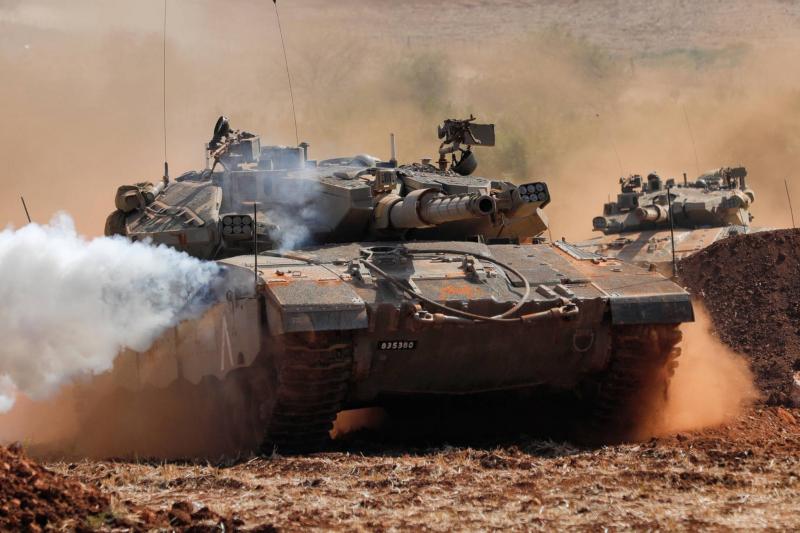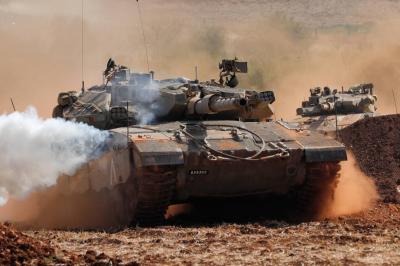Since the attack on October 7, Israel has mobilized a significant number of armored forces within and around the Gaza Strip, as noted in a study by the Institute for Global Security and Defense Studies. Mobilization also occurred along the border with Lebanon. Tel Aviv has been prompted to call up six armored, mechanized, and infantry brigades to ensure the capability to conduct extensive military operations against Palestinian factions and maintain control over the Gaza Strip, in addition to clearing paths for troop movement from mines.
**On the Northern Front with Lebanon**
A number of military headquarters operate along the northern border, including the newly established headquarters of Division 146:
- The headquarters is located 9 km from the southern Lebanese border.
- It became operational following the escalation of military activities in northern Israel after the Al-Aqsa Flood operation.
- Division 146 includes an infantry brigade, an armored brigade, and a paratroopers brigade, along with an artillery battalion.
- Supporting formations at the headquarters include Operations Command, Communications Command, Intelligence Command, and units responsible for the headquarters' security.
- The current mission is to manage defensive efforts in ongoing confrontations within the western sector on the northern front with Lebanon.
On Tuesday, the headquarters faced a violent attack from Hezbollah, coinciding with a visit from the Israeli Chief of Staff.
**Details on Brigade Deployments**
The study observed the deployment of the Israeli army's "Brigade 460," an independent armored brigade, and "Brigade 205" from Division 146 among the forces. Additionally, "Brigade 474," a mechanized brigade from Mechanized Division 210, along with the mechanized infantry Brigade 11, which is supported by armored units, especially of the "Tiger" model, from Mechanized Division 99.
According to the institute, the armored Division 162, known as the "Steel Division," one of the most powerful armored divisions in Israel, has undertaken the attack on Beit Hanoun and Beit Lahiya in the northern Gaza Strip from the northern and northeast directions. Division 162 includes the armored Brigade 401, which serves as the division’s striking armored force, along with "Brigade 84 Givati" and "Brigade 933 Nahal," both mechanized brigades.
Notably, "Nahal Brigade," one of the elite forces with advanced training in Israel, was deployed by military command in the 2014 operation on the Gaza Strip to capture areas in Beit Hanoun, where it engaged in fierce battles with Al-Qassam Brigades, the military wing of Hamas. Meanwhile, "Brigade 84 Givati," one of the oldest elite brigades in Israel, includes special operations battalions, such as Battalion 846, known as "Sho'ali Shimshon" (Sons of Shimshon), which received advanced training lasting a year and two months in counter-terrorism, reconnaissance, sabotage, and sniping. The brigade also has specialized military engineering units like the "Dolev" engineering unit.
On the same front, Israel deployed Brigade 460, an independent armored brigade, to assist the division. The northern front has witnessed some of the fiercest combat, with Hamas announcing the loss of Northern Brigade commander and military council member Ahmed Ghandour and several other military leaders during the confrontations on November 26.
According to the study, Israel has also deployed the reserve armored Division 36, known as the "Division of Wrath," which is one of the largest armored formations operating in the Israeli army, comprising two armored brigades, the seventh and 188th armored, known as "Brigade Barak," as well as the Golani Brigade, known as "Brigade Number 1," which is considered the strongest elite brigades in Israel.
Division 36 is serving in the northern area, but the Israeli army has moved the formation to the operational area in Gaza to strengthen its ground capabilities for an assault on the sector, especially with the division being supported by Brigade 205 from armored Division 146. The Gaza Division, which is Division 252 (reserve), was one of the main targets of Hamas attacks on October 7, previously referred to as the "Sinai Division." It includes the 10th and 14th armored brigades.
The army also deployed Brigade 474, a mechanized brigade from Division 210, along with mechanized infantry Brigade 11 from Division 99. Additionally, two airborne brigades, 35 and 551 from Division 98, specializing in air assaults, were dispatched.
**Task Map and Lines of Engagement**
After the massive buildup of forces, the Israeli army distributed its divisions along two primary directions for the ground invasion in the initial phase. The first direction is northern, and the second is eastern.
In the northern direction, the army's lines extend from the north of the Gaza Strip towards the coastal axis, leading to the streets of Al-Rashid and extending to Ahmed Arabi Street along the Mediterranean coast. According to the study, "Givati" from armored Division 162, in cooperation with the independent armored Brigade 460, and in addition to a combat group from mechanized Brigade 474/Mechanized Division 210, has been tasked to advance from north to south toward the "Shati" camp, while completing the destruction of the capabilities of Palestinian factions and securing the coastal road linking with the forces of Brigade 401 that operate south of the forces' domain.
Simultaneously, combat missions for Brigade 48 Golani and independent Brigade 460 have concluded in the areas of Al-Tuwam and Al-Saftawi west of Jabalia, while "Nahal" advanced from north of the Shati camp westward to Jabalia, along with mechanized Brigade 11. The armored Brigade 10, supported by airborne forces, advanced toward Jabalia to secure the areas that have been captured.
In the Sheikh Radwan area, the armored Brigade 401 from Division 162 is heading south through the Nasr neighborhood reaching the security square in Gaza City in the western sector, while forces from Brigade 84 Givati and Brigade 460 are preparing to engage in the area near the security square and hospitals, with the responsibility of securing the extension of Al-Rashid coastal road (and Ahmed Arabi Street) to connect with the forces of the reserve armored Division 36 operating to the south along the coast.
**Erez Axis/Salah al-Din Road: Heavy Armor**
In this area, Tel Aviv has mobilized joint armored forces supported by airborne units from Division 98. The 14th armored Brigade from Division 252 is tasked to advance toward Beit Hanoun, while the 205th armored Brigade from Division 146 advances with a battalion from Golani Brigade and a battalion from airborne Brigade 35 targeting Beit Lahiya in the northern sector.
The Israeli combat groups in Beit Hanoun and Beit Lahiya, which are close to the northern border of the Gaza Strip, aim to destroy the forces and equipment of the Palestinian factions in both areas, isolating one from the other. Furthermore, they aim to isolate the forces belonging to factions from their tactical surroundings in Jabalia, thereby creating isolated security squares where Israeli forces can eliminate personnel and capabilities in small areas of land, especially as the region north of the Gaza Strip has witnessed multiple operations and rocket fire towards Ashkelon and Ashdod, in addition to attacking the gathering of forces in Zikim.
**Eastern Direction: The Target is Gaza**
The eastern direction differs due to its long stretch of 40 kilometers, reaching the intersection of the Gaza border with Egypt. This direction is characterized as the area where the main attacks occurred on October 7, which included deep strikes reaching up to 22 kilometers east of the sector.
According to the institute's observations, Israel has deployed various forces along this axis with diverse missions. The 101st Airborne Battalion from Brigade 35 has been mobilized alongside mechanized infantry Battalion 13 from Golani Brigade to operate in the Sheikh Ajlin area southwest of Gaza City. In contrast, the Israeli army deployed Golani Brigade, except for one battalion, to control areas in Tal Al-Hawa and the Zaytoun neighborhood south of the city.
As for the armored force, Brigade 188 from Division 36 moved to operate in the port area of Gaza in the western sector, while the Israeli army deployed the seventh armored Brigade from the same division to operate in the southern area of the Rimal neighborhood. In the Juhar al-Dik area, where fierce clashes and successive attacks by Palestinian factions have occurred, forces from the fifth infantry Brigade are dispersed.
The forces are working toward two main objectives: first, to secure the coastal axis extending from the north to the south of Gaza city, and second, to isolate Gaza City from the Jabalia refugee camp to the north and neighborhoods of Shuja'iyya and Turkman to the east. This is aimed at preventing any support to Palestinian fighters with fire or troops, facilitating any future efforts to breach into the heart of Gaza City and capture it if a lull collapses.
**Central and Southern Gaza: Cautious Fighting**
Although the primary operations concentrated in the initial phase in northern Gaza Strip and Gaza City, the Israeli army has indeed mobilized forces to confront what the Israeli Chief of Staff referred to as "the second phase of ground maneuver," which is expected to include a ground incursion into southern and central Gaza.
On a military level, the study documented that Israel mobilized the independent infantry Brigade 838, excluding one combat group, to carry out operations in the Martyrs area and Kisufim Street. According to the institute, the tasks assigned to Israeli forces thus far involve "limited incursions and reconnaissance with troops," which constitute cautious military activities aimed at combatting any active Palestinian elements in central Gaza to prevent them from intervening to support the fighters in Gaza City and northern Gaza, where fierce battles have been taking place until they were halted due to the ongoing fragile ceasefire.
**Southern Gaza: Information Gathering**
The study noted the deployment of a combat group from the independent infantry Brigade 838, along with elements from the Search and Rescue Brigade, along the Sofa axis and Nasr Street. According to the institute, the forces stationed there have a primary mission of reconnaissance and search through means and targeted fire, especially in Khan Younis and its vicinity.
The study indicates that the nature of the troops and the volume of operations before the ceasefire suggest that the task sought by the Israeli army at this stage is to set ambushes and conduct intensive reconnaissance patrols, attempting to gather more information about the area, hostages, and movements of Palestinian fighters, besides the possibility of carrying out cautious attacks aimed at capturing elements of the Palestinian factions to present an image of achievement for Israeli forces.




